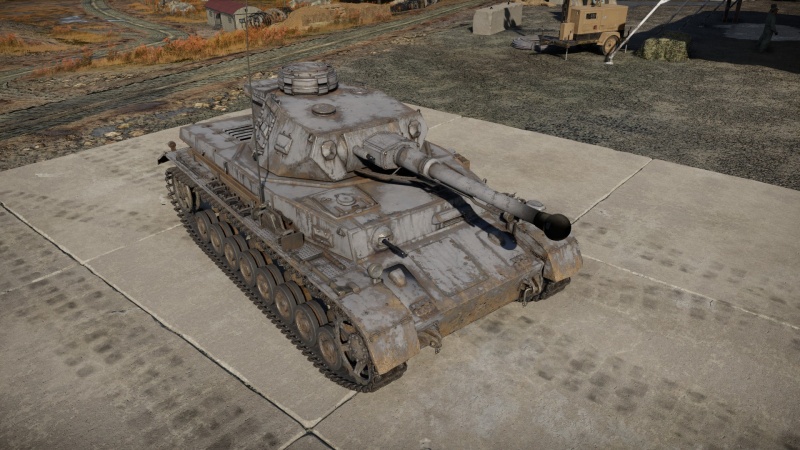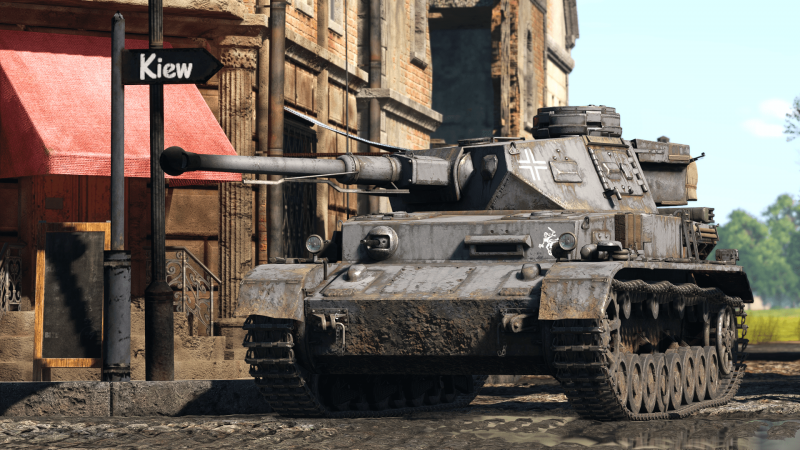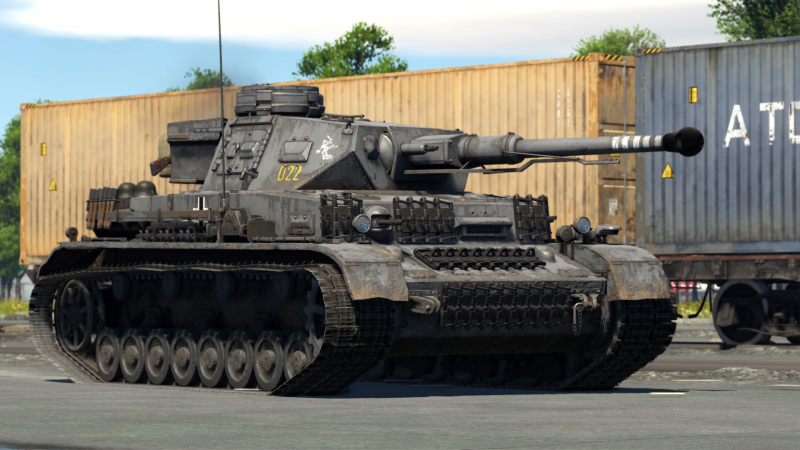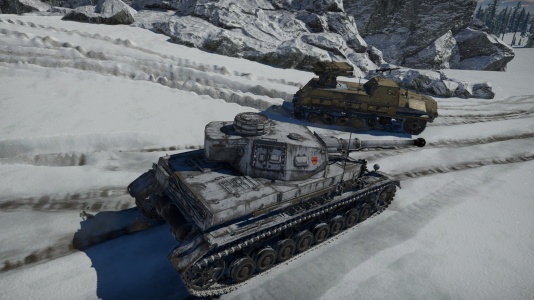Pz.IV F2
| This page is about the German medium tank Pz.IV F2. For other versions, see Pz.IV (Family). |
Contents
Description
The Panzerkampfwagen IV Ausführung F2 (Panzer IV F2) (Sd.Kfz. Index: Sd.Kfz. 161/1) is the late version of the sixth variant of the Panzerkampfwagen IV medium tank family. In order to combat the Soviet T-34 medium tanks and KV-1 heavy tanks, the Germans began upgrading their Panzer IV F1 with the long-barrelled 75 mm Kampfwagenkanone (KwK) 40 L/43 tank gun in early 1942. The new long-barrelled 75 mm KwK40 L/43 tank gun provided significantly increased projectile velocity and armour penetration. The Panzer IV F1 served as the foundation for this upgrade. These were initially designated as Panzer IV F2 to distinguish them from the short barrel Panzer IV F1 variant. These were all renamed Panzer IV G after July 1942. According to certain accounts, around 25 manufactured Panzer IV F1 tanks were rearmed with the larger gun, which replaced the short-barrelled 75 mm KwK37 L/24 tank gun previously used for infantry support.
Introduced in the Closed Beta Test for Ground Forces before Update 1.41, the Panzer IV F2 was identical to the Panzer IV F1 except for the long-barrelled 75 mm KwK40 L/43 tank gun. Players will be surprised by this new revised Panzer IV F2, as the long-barrelled 75 mm tank gun provides much-increased projectile velocity and armour penetration. Due to the increase in calibre from 50 mm on Panzer IIIs to 75 mm on Panzer IV F2, destruction of enemy vehicles is generally immediate upon successful penetration.
General info
Survivability and armour
The armour of the Panzer IV Ausf. F2 is virtually identical to that of the Ausf. F1. With a maximum thickness of only 50 mm, it is quite thin compared to that of its arch-rivals, the T-34 and M4 medium tanks, and can be easily penetrated by most medium calibre guns and is also mostly unangled. The side and rear armour is even thinner and is highly vulnerable to even autocannons commonly used by anti-aircraft vehicles at medium and close ranges.
The hull armour can be supplemented by add-on armour in the form of track links, but the turret remains highly vulnerable since it receives no extra protection even with the upgrade. The turret also sports a relatively large cupola that is just thick enough to cause some rounds with explosive filler to detonate after penetration, potentially killing the entire turret crew. It is also important to note that the roof armour is only 10 mm thick, and is quite vulnerable to aircraft heavy machine guns and cannons.
The crew compartment is relatively compact and has a lot of ammunition scattered all over. Penetrating hits are likely to be quite devastating, especially if the shell has an explosive filler.
Armour type:
- Rolled homogeneous armour
- Cast homogeneous armour (Cupola)
| Armour | Front (Slope angle) | Sides | Rear | Roof |
|---|---|---|---|---|
| Hull | 50 mm (12°) Front plate 20 mm (73°) Front glacis 50 mm (13-59°) Lower glacis |
30 mm | 30 mm (4-15°) | 10 mm |
| Turret | 50 mm (11°) Turret front 50 mm (7-29°) Gun mantlet |
30 mm (23-26°) | 30 mm (15-17°) | 10 mm |
| Cupola | 30 mm | 30 mm | 30 mm | 10 mm |
Notes:
- Suspension wheels are 15 mm thick, while the tracks are 20 mm thick.
Mobility
| Game Mode | Max Speed (km/h) | Weight (tons) | Engine power (horsepower) | Power-to-weight ratio (hp/ton) | ||||
|---|---|---|---|---|---|---|---|---|
| Forward | Reverse | Stock | AoA | Stock | Upgraded | Stock | Upgraded | |
| Arcade | 48 | 9 | 22.3 | 0.35 | 465 | 572 | 20.81 | 25.2 |
| Realistic | 43 | 8 | 265 | 300 | 11.86 | 13.22 | ||
The mobility of the Ausf. F2 is comparable to that of the earlier Pz.IV F1, though slightly worse due to the heavier gun. It is decent enough for a medium tank, especially since the Ausf. F2 is less reliant on flanking due to its powerful gun, and it can keep up with most advances without problem. The reverse speed of 10 km/h is also relatively good, allowing it to back off fairly quickly for a medium tank.
Its adequate speed and cross-country capability (with Ostketten equipped) grant the F2 a good ambushing capability to go quickly around enemy positions and surprise them.
Modifications and economy
Armaments
Main armament
The biggest difference between the Ausf. F2 and the Ausf. F1 is the new long-barreled 7,5 cm KwK40 L/43 gun. As easily the best gun available to any medium tank at the Ausf. F2's BR, the KwK40 has absolutely no problems dealing with all but the heaviest tanks at this BR, even from the front. It is even quite capable against higher tiered tanks, with only a few exceptions. The turret also provides the gun with an excellent amount of gun depression, allowing the effective use of hull-down tactics.
The stock PzGr 39 APCBC shell is also the best all-round ammunition to use. It is much more effective against sloped armour than the PzGr 40 APCR shot and even at 2,000 m has more penetration than the HlGr 38B HEAT shell. The only reason to carry any APCR at all is in case of a full uptier, where very heavily armoured tanks such as the Churchill VII may be faced and only shots to the front are possible.
Smoke and HE shells are also available, although their use is rather situational.
| 75 mm KwK40 L43 | Turret rotation speed (°/s) | Reloading rate (seconds) | |||||||||||
|---|---|---|---|---|---|---|---|---|---|---|---|---|---|
| Mode | Capacity | Vertical | Horizontal | Stabilizer | Stock | Upgraded | Full | Expert | Aced | Stock | Full | Expert | Aced |
| Arcade | 87 | -10°/+20° | ±180° | N/A | 13.3 | 18.4 | 22.4 | 24.8 | 26.4 | 7.67 | 6.79 | 6.25 | 5.90 |
| Realistic | 8.3 | 9.8 | 11.9 | 13.2 | 14.0 | ||||||||
Ammunition
| Penetration statistics | |||||||
|---|---|---|---|---|---|---|---|
| Ammunition | Type of warhead |
Penetration @ 0° Angle of Attack (mm) | |||||
| 10 m | 100 m | 500 m | 1,000 m | 1,500 m | 2,000 m | ||
| PzGr 39 | APCBC | 137 | 135 | 123 | 110 | 98 | 88 |
| Hl.Gr 38B | HEAT | 80 | 80 | 80 | 80 | 80 | 80 |
| PzGr 40 | APCR | 163 | 159 | 143 | 126 | 110 | 96 |
| Sprgr. 34 | HE | 10 | 10 | 10 | 10 | 10 | 10 |
| Shell details | ||||||||||||
|---|---|---|---|---|---|---|---|---|---|---|---|---|
| Ammunition | Type of warhead |
Velocity (m/s) |
Projectile mass (kg) |
Fuse delay (m) |
Fuse sensitivity (mm) |
Explosive mass (TNT equivalent) (g) |
Ricochet | |||||
| 0% | 50% | 100% | ||||||||||
| PzGr 39 | APCBC | 740 | 6.8 | 1.2 | 14 | 28.9 | 48° | 63° | 71° | |||
| Hl.Gr 38B | HEAT | 450 | 4.4 | 0.05 | 0.1 | 872.1 | 62° | 69° | 73° | |||
| PzGr 40 | APCR | 919 | 4.1 | - | - | - | 66° | 70° | 72° | |||
| Sprgr. 34 | HE | 550 | 5.74 | 0 | 0.1 | 686 | 79° | 80° | 81° | |||
| Smoke shell characteristics | ||||||
|---|---|---|---|---|---|---|
| Ammunition | Velocity (m/s) |
Projectile mass (kg) |
Screen radius (m) |
Screen deploy time (s) |
Screen hold time (s) |
Explosive mass (TNT equivalent) (g) |
| K.Gr.Rot Nb. | 540 | 6.2 | 13 | 5 | 20 | 50 |
Ammo racks
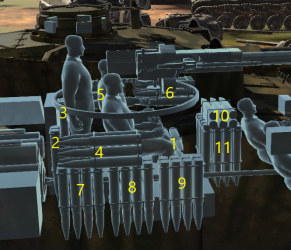
| Full ammo |
1st rack empty |
2nd rack empty |
3rd rack empty |
4th rack empty |
5th rack empty |
6th rack empty |
|---|---|---|---|---|---|---|
| 87 | 84 (+3) | 82 (+5) | 80 (+7) | 72 (+15) | 63 (+24) | 54 (+33) |
| 7th rack empty |
8th rack empty |
9th rack empty |
10th rack empty |
11th rack empty |
Visual discrepancy |
|
| 46 (+41) | 38 (+49) | 30 (+57) | 24 (+63) | 1 (+86) | No |
Notes:
- Racks are modeled by sets of 2 and disappear after both shells in the set having been shot or loaded.
- Sides empty: 30 (+57) shells
- The tank can carry up to 87 rounds, which is more than sufficient for most battles. It is recommended to carry fewer rounds, as this will reduce the likelihood of ammunition detonation if the turret is penetrated.
Machine guns
| 7.92 mm MG34 | ||||
|---|---|---|---|---|
| Mount | Capacity (Belt) | Fire rate | Vertical | Horizontal |
| Coaxial | 3,000 (150) | 900 | N/A | N/A |
Usage in battles
A veritable glass cannon, the Ausf. F2 has one of the best guns of its battle-rating, balanced by its poor armour. This makes it rather more oriented towards long and medium-range combat, where the thin armour is less of an issue and its powerful gun gives it a big advantage in firepower over its peers. Like the American M4s, the Ausf. F2 has a good amount of gun depression, which allows the player to hide the tank's entire hull behind terrain and only expose its turret while shooting. Unlike the M4, however, the F2's turret is unable to deflect almost anything that hits it, and it will wither quickly under concentrated fire. Unlike the T-34, the Ausf. F2 cannot hope to bounce anything but the weakest guns from the front, and should thus be played a lot more cautiously. This means hiding behind structures, and generally keeping a long distance away from the enemy as its armour is too weak to withstand any tank gun at it's battle rating. Which also means setting up a playstyle of sniping players from long distances.
The 75 mm gun will frontally penetrate all but the most heavily armoured tanks even with the stock APCBC. Combined with the explosive filler in the APCBC shell, the Ausf. F2 is a very dangerous threat that even higher BR tanks can ill-afford to ignore. Only the Churchill VII is reasonably immune, but even its frontal armour can be penetrated by the APCR shell at close ranges. However, it may be more efficient to simply flank around and use the APCBC shell against the sides, since the APCR round lacks post-penetration effectiveness. This combination of an excellent gun, relatively good mobility, and good gun depression allow the Ausf. F2 to remain quite competitive even in up-tiers, where other medium tanks begin to struggle against the heavier tanks that can be faced.
Enemies worth noting:
- ZSD63: This SPAA has access to a full AP belt with 60+ mm of penetration ,which makes it able to penetrate the Pz.IV F2 from any angle up close, and its quick fire rate can knock out the entire crew with a short burst. If the add-on track armour is installed, it might actually save the Pz.IV F2 in a frontal encounter, as it would make the frontal hull thick enough (at 50+20=70mm thick) to resist the autocannon. Do not shoot at the hull below the turret as there is absolutely nothing inside, shoot the turret or the front hull instead. Multiple shots might be needed as its armour is so thin the 75 mm shells will not detonate. When reloading, slightly angle the Pz.IV F2 turret to avoid the return fire from penetrating the thin turret cheeks. When hunting down a ZSD63, it has a rather body and tall hull with a geometric turret sitting at the back, slightly similar to a Wirbelwind's. The firing signature is also rather distinctive: the sound and green tracers are very rapid, much like a buzzsaw, but then it will remain silent for half a minute reloading. Note that an experienced ZSD player will hold its fire or shoot in single salvos with long halts between, making it look like that it's reloading so be careful when exposing the Pz.IV F2 for an attack.
- GAZ-72K and ZIS-12: These two SPAAs have a deadly 25mm autocannon(with the ZIS-12 having two) with a 70+mm of penetration in their AP belts, they can melt the IV.F2 from mid-close range at any angle. It is also worth noting that the speed of the 2 SPAAs is very fast, meaning that an F2 player is likely to get flanked if they decided to push the frontline for their teammates. The best way to counter these SPAAs is to fire a HEAT/HE round(if the player has one loaded) or fire the stock APCBC round onto the driver port and then use the machine gun to quickly take out their other crews. Make sure to do this quickly before they had a chance to shoot you.
Pros and cons
Pros:
- Outstanding penetration and lethality with the stock APCBC shell; easily knocks out common targets with a single shot
- High-penetration APCR shot can effectively deal with up-tier heavy tanks, e.g. Churchill Mk VII
- Excellent gun depression of -10° provides great mountain warfare capacity.
- Great mobility and top speed compared to later Panzer IV variants. Hull traverse in is better than the M4 Shermans
- Space between the driving and fighting compartment can absorb some solid shells, might be helpful when facing British tanks like the Cromwell
- Reasonably small profile, can hide behind some large objects
- Add-on armour increases survivability against certain vehicles, for example the ZSD63.
Cons:
- Thin armour overall, can be knocked out with a single shot by common targets like the T-34 and M4, or even low tier tanks like the M3 Stuart and SPAA auto cannons. The add-on armour generally doesn't help much against tank cannons.
- The APCBC shell is highly likely to over-penetrate enemies with 10-20mm armour meaning that the post penetration damage fuse is too slow to react to the thin armour of said vehicle.
- Rather cramped crew compartment with ammunition scattered all over meaning ammo racks are generally more likely to happen.
- Large and weak commander's cupola. When penetrated by an explosive shell, all crew inside the turret, including the gunner, are likely to get knocked out.
History
Development
The Pz.Kpfw. IV's creation, like its predecessor the Pz.Kpfw. III, was devised by Heinz Guderian. He envisioned a support tank to be used to handle anti-tank guns and fortifications. The Panzer IV was to work alongside the more numerable Panzer III in Panzer Divisions (three company of IIIs and one of IVs) to engage the enemy, giving the role of fighting enemy armoured forces to the Panzer IIIs. As a support tank, the tank was to have the short 75 mm howitzer as its main armament and have a weight limit of 24 tons. MAN, Krupp, and Rheinmetall-Borsig worked on the development of the tanks, but the Krupp's model was selected for further testing.
The chosen model from Krupp, once finished, used a leaf-spring double-bogie system for its suspension, doing away the proposed interleaved or torsion bar suspension system earlier devised for the sake of faster production. The vehicle held five crew members: the commander, gunner, loader, radio operator (and hull machine gunner), and driver. Though it looked symmetrical, the Panzer IV turret was actually offset to the left of the chassis centerline a bit while the engine was also offset to the right. This was to allow the torque shaft to turn the turret. The offset also meant that most of the ammo is held on the right side of the tank in storage areas. The Panzer IV was then accepted into service and production began in 1936.
Panzer IV Ausf. F2
With the appearance of the Soviet T-34 and KV-1 tanks. The Panzer IV Ausf. F1 with its short 75 mm howitzer was upgraded with the KwK40 L/43, then designating it the Panzer IV Ausf. F2. The new cannon was able to penetrate 77 mm of armour at 1,800 m with standard armour-piercing rounds compared to the 43 mm of the howitzer. The new gun helped put the Panzer IV back into balance and could theoretically hold against the T-34s and KV-1s that the Soviets were sending. The Panzer IV Ausf. F2 still retained the 50 mm front armour thickness with 30 mm on the sides.
Despite the new gun, it had some deficiency on the tank. First is a new weight, the tank now weighed 23.6 tons, and the heavy gun in front made the vehicle nose-heavy, enough that the forward suspension springs were always under compression, causing the tank to sway even without any steering.
Most of the F2 variants saw service in either Russia or against the Allies in Africa (though in very small quantities). In Russia, the Ausf. F could penetrate the T-34 at up to 1,600 m now and took part in Case Blue Offensive. In Africa, the Panzer IV Ausf. F2 could deal with all of the Allied armour available. The venerable Matilda was no match to its long range gun, and the M3 Lee was also helpless.
The Panzer IV Ausf. F2 still had some faults, and three months after its production started, it was renamed the Panzer IV Ausf. G with a few upgrades.
| Archive of the in-game description | |
|---|---|
|
The next variant of this tank was designed to increase its combat power. A new 75 mm 7,5 cm KwK40 gun with a long 43-calibre barrel and a muzzle velocity of 770 mps for armour-piercing rounds was developed by designers worked at the companies Krupp and Rheinmetall. The gun's barrel had a characteristic single-chamber muzzle brake and was mounted in a new mantlet with a new TZF 5f sight. A new ammunition stacking system was used, and the amount of ammunition carried was upgraded to 87 rounds, 32 of which were located in the turret. The armour on the gun's recoil devices was modified. This variant's operational weight was 23,000 kg. Production began releasing the new tanks in April 1942. The new tanks entered combat in the summer of 1942 and were able to fight the Soviet T-34 and KV, matching their firepower. The new tanks were completely superior to British and American tanks of the day. By July 1942, 175 Pz. IV Ausf. F2 had been manufactured, and another 25 had been converted from the F1. In May 1942, 8 tanks with increased armour thickness were released. These tanks took part in combat in Africa and on the Eastern Front in 1942 and 1943. In September 1942, 10 Ausf. F2 tanks were delivered to Nazi Germany's most loyal ally, Hungary. A number of captured tanks were used by the Red Army. Pz.Kpfw. IV Ausf. F2 tanks in use in 1942 and 1943 sported a huge variety of color schemes, since new types of camouflage were being adopted in February 1943. | |
Media
- Skins
- Sights
- Images
Panzer IV with winter camo alongside a 15 cm Pz.W.42 halftrack.
- Videos
See also
Links to the articles on the War Thunder Wiki that you think will be useful for the reader, for example:
- reference to the series of the vehicles;
- links to approximate analogues of other nations and research trees.
External links
Paste links to sources and external resources, such as:
- topic on the official game forum;
- other literature.
| Germany medium tanks | |
|---|---|
| Pz.III | Pz.III B · Pz.III E · Pz.III F · Pz.III J · Pz.III J1 · Pz.III J1 TD · Pz.III L · Pz.III M · Pz.III N |
| Pz.IV | Pz.IV C · Pz.IV E · Pz.IV F1 · Pz.IV F2 · Pz.IV G · Pz.IV H · Pz.IV J · Pz.Bef.Wg.IV J |
| Pz.V | VK 3002 (M) · Panther A · Panther D · Panther F · Panther G · Ersatz M10 · Panther II |
| M48 upgrades | M48A2 G A2 · M48 Super |
| Leopard 1 | Leopard I · Leopard A1A1 · Leopard A1A1 (L/44) · Leopard 1A5 · C2A1 · Turm III |
| Leopard 2 | PT-16/T14 mod. · Leopard 2K · Leopard 2AV |
| Leopard 2A4 · Leopard 2 (PzBtl 123) · Leopard 2A4M · Leopard 2 PL · Leopard 2A5 · Leopard 2 PSO · Leopard 2A6 · Leopard 2A7V | |
| Trophies | ▀M4 748 (a) · ▀T 34 747 (r) |
| Other | Nb.Fz. · KPz-70 |
| USA | mKPz M47 G · M48A2 C |
| USSR | ◊T-72M1 |



